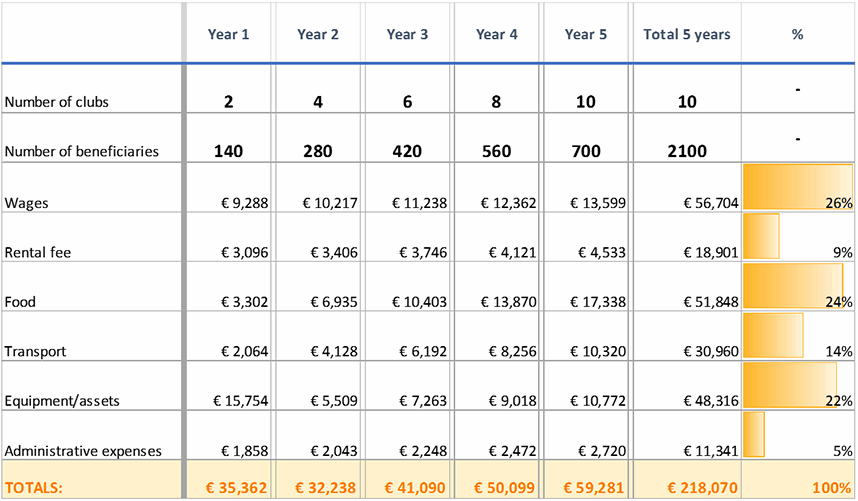4. Resources
|
Resources
|
Description
|
|
Human
|
Organization Council, project coordinators, warehouse supervisor, volunteers: leaders of local clubs, assistants
|
|
Physical
|
Equipment, gear for all above extreme activities, training aids, lease of premises, transport
|
|
Intellectual
|
Readymade programs for holding various events with the aids for teaching and developing teenagers:
- an annual program of events in each club;
- an annual program of personal development courses;
- a monthly English learning program;
- a program for mastering the skills of survival in the wild (building a shelter, getting food and water, etc.);
- a program for protecting teenagers from human trafficking and HIV diseases, etc.
|
|
Financial
|
Voluntary financial support of certain projects and events from persons willing to help develop the EXIT activities.
|
5. Required Budget

The budget is broken down by years, taking into account the rate of the project growth, whereby the number of clubs will increase by 2 every year. The expenditure items are calculated according to all planned activities specified in Section 4, the items are increased proportionally to the planned project growth from year to year.
Description of expenditure items:
1. Wages
Those, who do most of the work and their work cannot be voluntary, will get wages. These are two project coordinators and equipment and warehouse supervisor. There will be only three people in the first year and as the project expands, additional coordinators will be hired. In this case, the areas of responsibility of coordinators will not overlap.
2. Lease
The project concept provides for the lease of only an equipment warehouse, all other club premises are rented for several hours a week free of charge and with the support of local authorities and churches. Therefore, this item takes into account the warehouse, project growth, lease of premises for large events and some clubs.
3. Food
Since most of the project activities are connected with long-term events, it is necessary to spend money on providing food to the project participants. In this case, such snacks as cookies and tea are calculated for weekly clubs and courses. Sandwiches, drinks, hot dishes are calculated for longer events such as actions, quests, sports competitions. Even more longer events such as camps provide three meals daily and evening snacks. Celebratory dinners are calculated for such events as opening and closing of a season, Christmas, Easter, New Year. Moreover, since most of organizers are volunteers, the project provides for monthly short trainings in team building and motivation, which also include basic food. Therefore, this item of expenditure makes the largest share of the total budget. In all events, food will be provided to the participants at the expense of the project as they have no money even for such basic expenditures.
4. Transport
This expenditure item implies periodic gatherings of all project participants and transportation of the necessary equipment to one location for holding joint events such as camps, holidays, trainings, etc. Teenagers are transported at the expense of the project as they have no money even for such basic expenditures. Moreover, this item includes the transport expenses of coordinators and other organizers for performing their duties, which require trips from one locality to another.
5. Equipment/assets
This item includes costs of all equipment, stationeries, gear, training material and aids, consumables, which are necessary for the project implementation. At the same time, all gear necessary for tent camps, rafting, paintball games is already available. Of course, some gear will require upgrading in the course of the project. Moreover, this item for the first year includes additional 12000 for acquiring a cargo-and-personnel car with 5 seats, which can be used both for transportation of coordinators and for transportation of small freight, which is ideal for the project needs.
6. Administrative Expenses
This item constitutes only 5% of the budget and covers bank expenses and other administrative expenses of the organization.